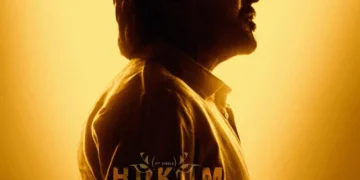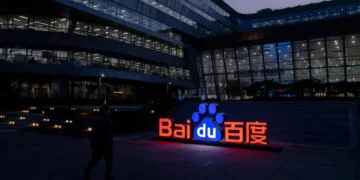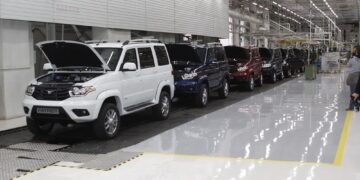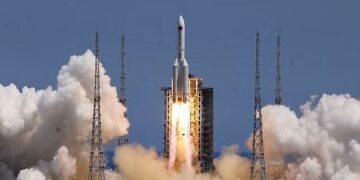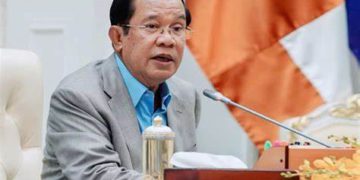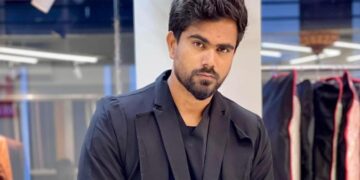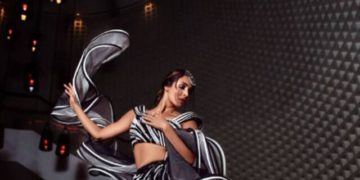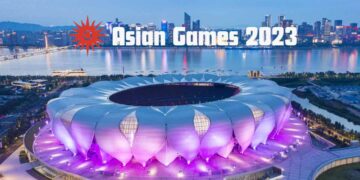Nestled amidst the Serene Landscapes of Angamali in Kerala Nisarga art Hub stands as a testament to the fusion of art and nature and the sustainable architecture overlooking a vast expanse of Patty Fields this unconventional Community residency is not just a house but a space where musicians and artists come together to create Magic.
An intimate conversation with the Visionary Minds behind this artistic Haven , Vishnu and Lakshmi.
How did you find this place and what made you uh come up with such a project which is so?
So, , we actually were living in Chennai and, around COVID, we thought we would come here to Kerala because Vish’s parents live here, and Vishno is basically from here. Okay, our intention was just to spend some time with family, but, the second child was only 6 months old, and we wanted to have the space for the kids to run around. So, it would seem perfect. So, we came here, but, uh, the lockdown kept getting extended, and concerts were not happening, and we had a lot of free time.
So, we thought, why not build a house? Because this was something that was there at the back of our minds, but we didn’t think we would do it this early on. Both of us, I think, commonly had this dream of building a mud house. There are very few architects who are actually into sustainable architecture, eco-friendly building. When we did some research, the one person whose work really stood out for us was Vinu Daniel from Wallmakers. We approached him, emailed him, he called us back, and he came to the site.
The site sort of inspired him, and he said he would take it on. The fact that we musicians gave him extra interest, or because he’s also into, he’s basically more of an artist than an architect, as you can see, absolutely stunning. If you look anywhere, you find some artistic elements. So, that is what actually inspired us to work with him. That is what made us choose him as an architect because we were blown away by the artistic, out-of-the-box thinking. It’s extremely creative. What he does is he factors into his buildings what the client is, who they are, what they do, and what they will be doing with the building that he constructs for them. The fact that we were musicians inspired him to think about how the space can be used for art, how can art flourish in a space that is usually thought of only as a place to live. But then when art is in an artist’s house, the artist only truly lives in a house when art can actually happen dynamically. So, that connection towards genuine, I guess.

Somewhere down the line, the construction took a long time; it was very stressful. Probably halfway through the construction, we got an idea about how it is shaping up. Then, that is when we were thinking, why not do something more, you know, use it as something more than a house. Yeah, for a better cause. That is when the idea of an art hub originated in our minds.
Can you tell us about yourselves and your journey in creating Nara Art Hub? What inspired you to start a community residency focused on art and culture? Concept and desire something like that.?
Initially, when this house was being constructed, we only had in mind probably a space where our students could come and learn, and for us to do some classes here. But as we thought more about it, we realized that there is a lack of a community of artists, a community for artists where people can come, like-minded people who love art can come and listen together, or learn together.
It’s a very informal setting where people will be encouraged to share their ideas themselves. I know this ambiance itself talks a lot; people coming here, they would just start singing. You don’t have to ask; the feel that you gave for this construction itself is like the artist comes in surely would want to give it a try to perform because the ambiance speaks out for itself. It’s definitely when there’s nature all around; it’s a huge inspiration for not just music, any art form, I think. The fact that there is no judgment, where no art is discriminated against or no idea is discouraged, I think helps people to think more deeply about certain things. When ideas are bounced off of each other, I think something beautiful comes about all the time.

We’ve only done three or four events here, but it’s all been very dynamic, very natural, very organic, but the artist has always felt at ease to present their best, and they tend to experiment too because this is a non-judgmental space. There’s no compulsion of your being certain criteria.
Now that we live in a very online world and there is a false sense of community around, I think people miss the human touch. When there is a physical presence of artists around you, it’s a whole other atmosphere, and there’s so much happening. There’s a lot of energy, and I think that energy also inspires people to be alive at the moment.
That’s what we experienced when we had our first Retreat, where for 3 days, we had people from so many states across India, even a couple of people who came from abroad. They stayed with us here for 3 days. We only offered a simple sleeping arrangement, but everybody was okay with it. One gentleman came from the UK, a 78-year-old Englishman, and he said it was sort of life-changing for him because he was going through certain things, and to be in the presence of a lot of music gave him the needed comfort, that’s what he said. So I think different people took different experiences away with them, but collectively, I think people felt that sense of being with family, and we created lasting friendships and relationships through these experiences. So everyone who walked in here surely would carry a bit of this place. That’s how we can put it; surely, the impact would be long-lasting.”
So how does the design of Nara art Hub with its traditional Cara roofs and Innovative features like skylights and and Earth a Amphitheater reflect your vision for the space ?
That’s an interesting question. So, I think the openness, where there’s a lot of light and air, and basically being almost close to nature—I mean, living with nature—I think only complements our vision. Because, like a few times, you see birds coming into the house because they don’t know whether this is the outside outdoors or indoors. It’s amazing.

Truly sitting inside this living room and looking eastwards, you feel that the living room is naturally extending to the end of the paddy field. It’s your room, kind of—you know, to some extent, you feel that you’re on top of the world. Correct, exactly, and top of the world, literally here because the outdoor amphitheater enables people to climb up to the topmost point of the roof and to listen to or watch art happening in front of them. And the moonlight, yeah, and stunning. Yeah, it really is.
Even we didn’t know that it would be such a fantastic atmosphere to experience art in. So, I think it all just happened organically. We didn’t really plan much of this, but what is happening is that the space and the art complement each other.
Can you explain the significance of the Shutter-Debris wall technique used in the construction? How does it contribute to the sustainability of the project?
It is a technique that involves construction based on soil, mainly procured from the nearby vicinity. We used red soil from the site itself and sourced some from neighboring land. The construction involves a mixture of fine and coarse soil, a little bit of cement, aggregate, and construction waste. This is where the concept of sustainability is introduced; waste becomes useful. This is a patented technique, and Vinu Daniel himself has the patent for it. He has used this technique in some of his houses. He’s the only one supposed to use this design or technique, and others need to take permission from him. He also uses various other waste materials, such as tires and discarded plastic toys, although not in this house. For instance, he recently worked on a project called ‘Toy Story’ where discarded plastic toys were utilized.
What type of events and activities do you host at the Hub, and how do they contribute to the local art and culture scene?”
That’s a great question. We want this to be an inclusive space where we bring different art forms. Every time, for now, we’ve had three events, and what happens with all our events, we have two parts to the event. One is a listening experience, we call it Nila Nadam because Nila means Moon, and this happens under Moonlight and on a full moon day. That’s a concept that’s basically entertainment plus more, maybe a little bit deeper experience. Maybe spiritual because it’s not just entertainment. The experience is usually deep; it stays with you for some time. So, let’s see what happens. The artists perform on a stage that is set on top of the water, and the audience is on the roof, and it’s under Moonlight, and there’s nature all around. It’s a very moving experience for the listeners as well as the artists sing. That happens along with. The second part of every month’s event is called Marga, where there’s a learning component, but usually by the same artist who performs. We have a workshop or a master class or a discussion or a communicative session where the art that is being performed is also being discussed or taught. Okay, so it’s explained in a way to understand what type of art you, and it can even be a practice session where students of music can practice with the performer. That kind of experience, I don’t think you can get much. Also, listeners of art form always wonder what goes into the journey of an artist and to experience that in a very intimate setting is actually lovely. I think we’ve had music students from across Kerala and even outside of the state, and they’ve come here and they’ve actually interacted with these artists, and it’s definitely contributed to their learning journey as well. Because there is a listening component and a learning component, I think they really go well with each other. We hope to bring in, for now, we’ve had one Dhrupad, which is a Hindustani classical concert plus workshop. The second one was a Kathak-based rhythm-based workshop and a concert also. The third was a Moonlight piano solo, and the artist also taught the students about music production. We’ve had varied experiences, and we hope to bring in more such different experiences.
One gentleman texted that he came to attend this event, and he mentioned that he had one of the toughest days in his life. However, at the end of the concert, after this event, he felt very smiley. It was something great to bring smiles to broken hearts. We felt that we were doing something, and it felt more like the intent was in us; it was happening organically. We say that the universe conspires to make things happen if you really want it. It felt like that because it was not just us bringing smiles to broken hearts, but we’re happy we could facilitate something like that. It really felt like it was happening.
There was another instance with a rapper who came. He had a hip-hop artist from Hyderabad, and he told us that for a year and a half, he wasn’t able to write anything. He had an artistic block. He took part in this retreat because he felt like he wanted to be with fellow musicians. He had no classical music background, and he was hearing the word “duat” for the first time. He didn’t have any clue what to expect, but he came because he knew it was going to be different. After three days of being with everybody, he wrote his first song in one and a half days. It was amazing how he released his thoughts.
Coming to challenges, we had plenty. During the construction phase, we faced a lot of challenges because this architecture or art is one of a kind. There is no template for this, no model to refer to. Everything had some learnings, positive and negative. Sometimes there were reworks. The whole construction process was extremely long, time-consuming, and also a bit expensive because it’s very labor-intensive. Moving around things in this area itself is challenging.
After the construction, one major challenge is that it is high maintenance. It’s not like a normal house where you can easily clean. We have challenges in cleaning and keeping it tidy. Regarding the challenges of the Nisarga art hub, it’s funding. We’re trying to run this on a purely nonprofit basis. All we want to do is break even because there are quite a lot of costs involved – artist remuneration, travel, accommodation, food for all the participants, sound amplification, and video documentation. We charge the participants, but due to limited space (no more than 40 attendees), we can source only something from the ticket revenue for now. The reason we’re continuing this is purely because we believe in the cause, and we have a few friends who believe in the cause and generously support us. Eventually, down the line, we might require some funding, some donors, and patrons.
For all the art events happening at Nisarga Art Hub , we’ve been collaborating with the World Music Festival Foundation. They’re also thinking along similar lines, aiming to bring globally popular art forms to India. They’re also nonprofit, so we’ve been collaborating. Similarly, we have individuals who want to contribute to the cause.
Regarding messages for readers and potential visitors to the hub, we sometimes get a lot of inquiries on our Instagram handle. People ask the same question: how do we visit? Sometimes we get random calls saying that they’ve reached nearby and can’t locate us. Since this is a residence, we’d like potential visitors to inform us upfront or get an appointment. We have a family and other things going on, so it’s not always easy to host people. We usually limit visits to one or two per day, but we get tons of inquiries. Those who want to come here can write to us at nsa. arthub@gmail.com or follow us on Instagram . Please message us before coming and get an appointment. We’d like to meet you, but please inform us beforehand.
If individuals want to get involved and support Nisa UB, they can do so by donating, becoming patrons of the cause, or volunteering their services to the art hub. Logistical support is needed for creating and maintaining a website, handling promotions, and managing events. Additionally, providing resources or sponsoring resources like sound and light equipment or even food is appreciated. Bringing in new ideas and artists, or performing if you are an artist, is another way to be part of the Nisarga Art Hub family.





